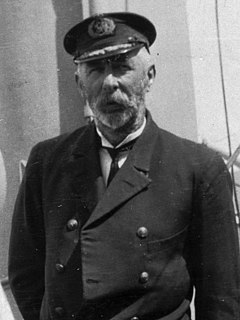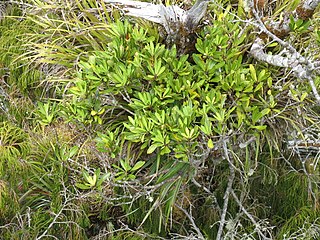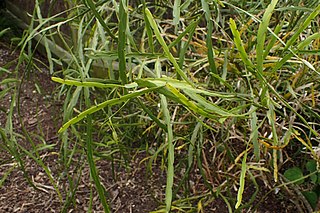Victor Dmitrievich Zotov was a New Zealand botanist.
Arthur William Baden Powell was a New Zealand malacologist, naturalist and palaeontologist, a major influence in the study and classification of New Zealand molluscs through much of the 20th century. He was known to his friends and family by his third name, "Baden".

Acaena novae-zelandiae, commonly known as red bidibid, bidgee widgee, buzzy and piri-piri bur, is a small herbaceous, prostrate perennial, native to New Zealand, Australia and New Guinea, of the family Rosaceae.

Pleioplectron is a genus of cave wētā in the family Rhaphidophoridae, endemic to New Zealand. These wētā are fairly common at night among the leaf litter in native forest in the South Island of New Zealand. The species look very similar to species of Miotopus, another New Zealand endemic genus, recently resurrected.

Thomas Frederic Cheeseman was a New Zealand botanist. He was also a naturalist who had wide-ranging interests, such that he even described a few species of sea slugs.

Chionochloa is a genus of tussock grass in the family Poaceae, found primarily in New Zealand with one known species in New Guinea and another on Lord Howe Island. Some of the species are referred to as snowgrass.

John Peter Bollons was a New Zealand marine captain, naturalist and ethnographer. For many years he captained New Zealand government steamers, including the NZGSS Hinemoa, which undertook lighthouse work and patrols through New Zealand's subantarctic islands. Bollons Island, in the Antipodes Islands, is named after him. In 1928 he was appointed a Companion of the Imperial Service Order.
Phenacoleachiidae is a family of scale insects commonly known as the phenacoleachiids. They are found only in the South Island of New Zealand, and on certain offshore islands. There are two species in a single genus.

Pittosporum kirkii is a glabrous evergreen perennial shrub that reaches up to 5 metres (16 ft) in height and possesses distinctive coriaceous, fleshy, thick leaves. It is one of four shrubs endemic to New Zealand that frequently displays an epiphytic lifestyle. P. kirkii is commonly epiphytic, perched amongst nest epiphytes in the canopies of emergent or canopy trees in old-growth forest; however, it can be observed occasionally growing on the ground or over rocks. Kirk first observed P. kirkii on Great Barrier Island. It was described by Joseph Dalton Hooker from material collected by Thomas Kirk, possibly from the Thames Goldfields, and published in 1869. The initial brief description titled Pittosporum n. sp.? by Thomas Kirk was published in his paper on Great Barrier Island in 1868. This description along with herbarium specimens were sent to Dr. J. D Hooker at Kew Gardens in 1868, and he collaborated to name it after T. Kirk, by giving it the specific epithet kirkii within the publication that was otherwise written by Kirk.
Donald Petrie was a Scottish botanist noted for his work in New Zealand.
Zotovia is a genus of plants in the grass family, native to New Zealand.

Zanthoxylum pinnatum, commonly known as yellow wood, is a species of flowering plant of the family Rutaceae native to Lord Howe and Norfolk Islands. It is a tree with pinnate leaves, white male and female flowers arranged in groups in leaf axils, and spherical, purple follicles containing a single black seed.
Althenia bilocularis is a plant found in both Australia and New Zealand, in fresh to brackish waters. In Australia it is found in all mainland states with the exception of the Northern Territory. In New Zealand it is found on the North, South and Chatham Islands.

William George Howes was a New Zealand entomologist and businessman.

Corybas cheesemanii, commonly known as Cheesemans spider orchid or spurred helmet orchid, is a species of terrestrial orchid endemic to New Zealand. It is a small orchid with a single pale green, heart-shaped leaf and usually only a single flower variously coloured from maroon to completely white. It usually grows in deep shade, often in deep leaf litter and flowers in autumn and winter.

Carmichaelia williamsii is a species of pea in the family Fabaceae. It is found only in the North Island of New Zealand. Its conservation status (2018) is "At Risk (relict)" under the New Zealand Threat Classification System.

Arthur Thomas Pycroft was a New Zealand naturalist and collector, known especially for his ornithological work. Pycroft worked for the New Zealand Railways Department and became a senior manager, but he retired young after receiving a large inheritance. This gave him more time for his real passion as a naturalist and ornithologist. He organised expeditions, mostly to islands off the coast of the North Island, with a focus on birds and plants. He grew rare plants at his large property in the Auckland suburb of Saint Heliers. Another of his interests was collecting rare books. When his library was put up for sale 40 years after his death, it was dubbed the "last great private library" in New Zealand. Pycroft held membership with the Auckland Institute at Auckland Museum for 75 years and was the organisation's president in 1935–36.

Drepanacra binocula, known as the Australian variable lacewing, is a species of brown lacewing in the family Hemerobiidae, found across Australia and New Zealand, including Lord Howe Island, Norfolk Island and the Kermadec Islands.

Micromus bifasciatus, is a species of Australasian brown lacewing in the family Hemerobiidae that was first described by Robert John Tillyard in 1923.

Protobiella zelandica is a species of New Zealand beaded lacewing in the family Berothidae that was first described by Robert John Tillyard in 1923. It is the sole endemic species in Berothidae found in New Zealand. No subspecies are noted in the Catalogue of Life.













